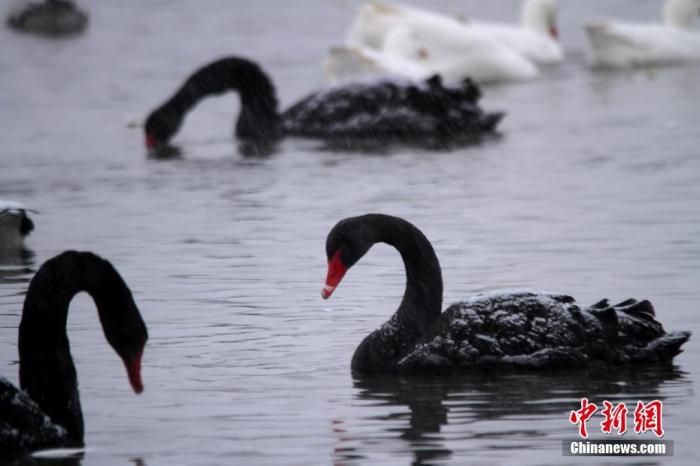China News Service, February 2nd. The Office of the Major Animal Disease Prevention and Control Headquarters in Haidian District, Beijing issued on the 1st "Notice on the infection of H5N8 subtype highly pathogenic avian influenza in wild black swans in Yuanmingyuan Relic Park". A total of 3 black swans died in the heritage park and were diagnosed with H5N8 subtype highly pathogenic avian influenza.
The disease only occurs locally and has been effectively controlled. No infection has been seen in other areas.
Data map: Black Swan.
Photo by Chen Li posted by China News Agency Photo source: CNSPHOTO
According to the "Bulletin", from January 22 to 25, 2021, three black swans died in the Yuanmingyuan Ruins Park.
The clinical diagnosis, pathological necropsy and laboratory diagnosis of the Haidian District Animal Disease Prevention and Control Center and the Beijing Animal Disease Prevention and Control Center were diagnosed as H5N8 subtype highly pathogenic avian influenza, and the samples were sent to the national avian influenza reference according to the procedures Laboratory review.
The black swans are native to Australia. In February 2008, a pair of black swans flew to the Yuanmingyuan Ruins Park and thrived here.
A total of 15 wild birds inhabit the diseased area of the Yuanmingyuan Relics Park, including 5 black swans, 8 mallards, and 2 black water chickens.
According to the "Bulletin", the circulation of 3 sick and dead black swans found that 2 adult black swans belonged to the same litter and had poor physical fitness. The other one was a 9-day-old young black swans with weak immunity.
Coupled with the cold weather in winter and spring, it is a period of high incidence of highly pathogenic avian influenza, thus increasing the risk of infection of highly pathogenic avian influenza virus.
The transmission of avian influenza virus is mainly through contact with infected poultry and their secretions and excrement, etc., through respiratory and digestive tract infections, and wild birds and birds are easily cross-infected during migration.
The "Notice" mentioned that the Haidian District Major Animal Disease Prevention and Control Headquarters Office carried out emergency response work under the guidance of experts from the Beijing Animal Disease Prevention and Control Center.
The specific prevention and control measures are as follows:
(1) Establish cordon and warning signs for black swan habitats in the park, implement closed isolation management, install isolation measures in the habitat of sick black swan, and establish a record of the alert situation;
(2) Disinfect all wild bird habitats and feeding places in the park three times a day, each disinfection is about 6000 square meters;
(3) Discourage tourists from approaching wild birds and prohibit feeding.
The breeding and management personnel in the park should do a good job of personal safety protection, fill in personal protection records, and wear protective equipment such as gloves and masks as required;
(4) Strengthen inspections in the park, conduct daily inspections of wild bird habitats in the area, observe the health status of wild birds, report abnormalities found immediately, and fill in records of wild bird health conditions;
(5) Investigate other key wild bird habitats within the jurisdiction and report the findings immediately; carry out environmental sample testing on wild bird habitats in the area.
The "Notice" pointed out that since last year, wild and poultry H5N8 epidemics have occurred in a large area in Europe, the Middle East, East Asia and other regions.
According to a report from the World Health Organization, there have been no cases of human infection with H5N8 avian influenza in the world.
There is no poultry breeding in the area 5 kilometers from the edge of the Yuanmingyuan Ruins Park.
After the outbreak, the Haidian District Major Animal Disease Prevention and Control Headquarters Office immediately activated the emergency response mechanism, carried out emergency response, carried out inspections of wild birds in the area, and carried out killing and killing of wild bird habitats. As of now, no abnormalities have been found; January 26 As of the 30th, a total of 257 samples of wild birds and habitat environment were collected and sent for inspection, covering the Yuanmingyuan Relic Park and other key waters wild birds habitats in Haidian District. The results were all highly pathogenic birds tested by the Beijing Animal Disease Prevention and Control Center. The flu is negative.
It shows that the disease only occurs locally and has been effectively controlled, and no infection has been seen in other areas.

